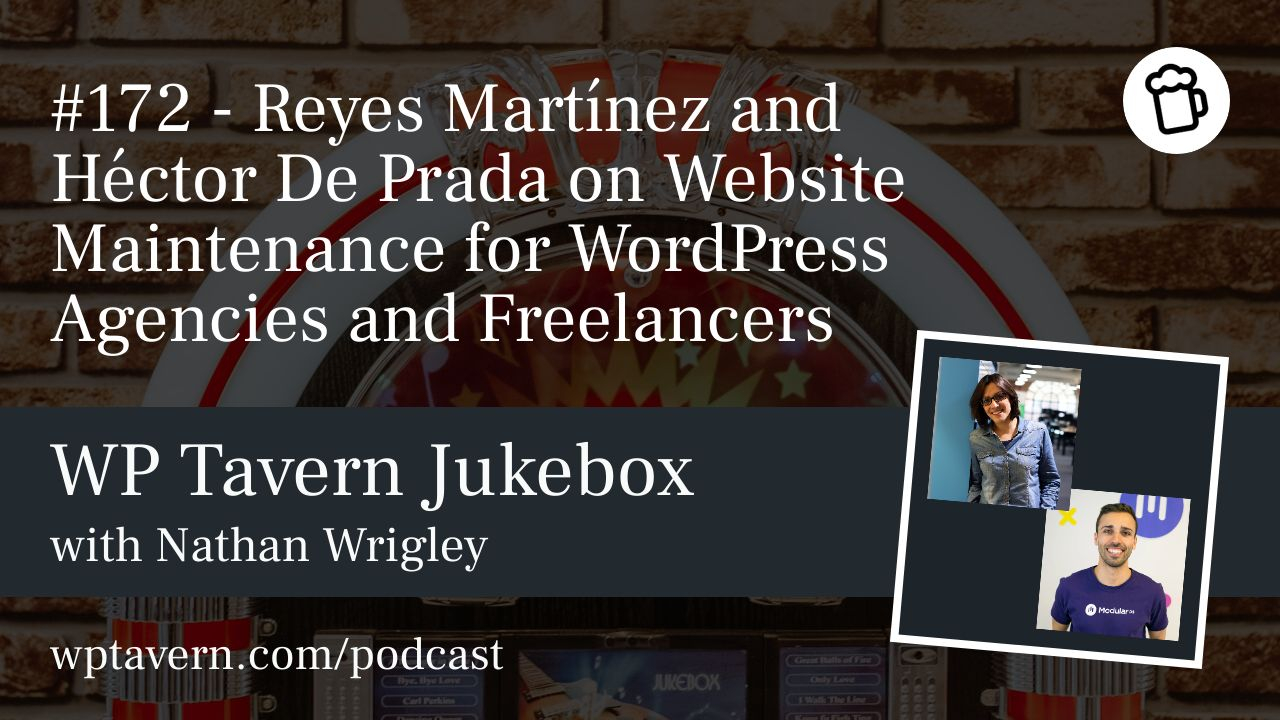Content:
[00:00:19] Nathan Wrigley: Welcome to the Jukebox Podcast from WP Tavern. Today’s episode is about website maintenance for WordPress agencies and freelancers. Guests: Reyes Martínez and Héctor de Prada from Modular DS.
Introductions
Reyes Martínez: Involved in WordPress since 2015; background in journalism, digital communications, and startups. From 2021–2024 she contributed full-time to WordPress marketing sponsored by Automattic. Now content lead at Modular DS.
Héctor de Prada: Building websites since his early teens, working with WordPress for nearly a decade—freelancer turned agency owner. Co-founder of Modular DS; organizes a WordPress meetup in León, Spain.
Why maintenance matters
Nathan frames the episode for listeners moving from a single-site hobby to managing multiple client sites. Maintenance isn’t glamorous but is essential for keeping sites secure, performant, and functional. Tasks scale quickly when managing many sites, turning a simple chore into a significant business need.
What maintenance involves
Héctor: Core, plugin, and theme updates are crucial. WordPress core updates happen less frequently now but still matter. Security is the main reason to update: vulnerabilities in plugins/themes can expose sites to attacks. Many plugins are independently developed, so human error and exploits happen.
Reyes: Other essential tasks include regular backups, uptime and performance monitoring, vulnerability scanning, database cleanup, and checking that key site features (e.g., contact forms) work.
Héctor: Monitoring catches problems before clients report them. Automating backups and monitoring is ideal so sites are protected even if the maintainer is unavailable.
Explaining maintenance to clients
Héctor: Education is key. Many clients aren’t technical and don’t immediately see the need. Use analogies—maintaining a website is more like maintaining a car or house than buying a one-off product.
Reyes: Frame maintenance as care for long-term success. It’s like insurance: you hope you don’t need it, but you’ll be glad it’s there if something goes wrong.
Selling maintenance and recurring revenue
Nathan: Maintenance is often sold as monthly or annual care plans, creating recurring revenue. This stabilizes income compared with project-only work.
Héctor: Best practice is to include maintenance in proposals from the start—not as an afterthought. When included early, clients accept it as part of the project and the handoff is smoother.
Pricing and value communication
Nathan: Clients may resent paying for maintenance if nothing seems to happen month to month. Reporting helps justify ongoing fees.
Reyes: Use reports to show updates, monitoring activity, performance metrics, and how maintenance supports business goals. Clients care that sites are secure, fast, and functioning—not the technical minutiae.
Héctor: Add business-oriented data—analytics, search console insights, traffic sources—so clients see how the site performs and supports their business.
Tangible client offerings
Nathan: Offering a portion of maintainer time each month for small tweaks or updates makes plans feel tangible. Even if clients rarely use it, the availability adds perceived value.
Héctor: Many specialists and agencies focus solely on maintenance and manage large portfolios—some freelancers maintain hundreds of sites, which is feasible with automation tools.
Specialization and scale
Héctor: Maintenance workload depends on site type. A simple brochure site has different needs than a busy WooCommerce store. E-commerce requires more robust monitoring, backup strategies, and faster response plans.
Reyes: With no-code and AI making site launches easier, more sites may be left unmaintained. This increases the opportunity for professionals offering maintenance services.
Changes in the maintenance landscape
Héctor: Legal and regulatory shifts (e.g., data privacy, upcoming EU accessibility rules, Cyber Resilience Act) change what must be included in maintenance and open new upsell opportunities like accessibility checks and legal compliance reviews.
Reyes: AI and no-code tools increase volume of sites but may leave many neglected, raising demand for maintenance services.
Modular DS: what they offer
Héctor: Modular DS is a mixed SaaS + connector plugin solution. You connect client sites via a plugin to the Modular DS platform and centralize maintenance tasks: bulk updates, monitoring, vulnerability scans, backup management, and automated client reports.
White labeling and client-facing features
Héctor: Modular DS supports white-labeling for client reports and the connector plugin. Agencies can brand reports and plugin info so clients see agency branding rather than Modular DS.
Business opportunity and advice
Héctor: Maintenance can be a standalone business or a complement to agency work. Automation lets a single professional manage many more sites than they could build. Maintenance offers predictable recurring revenue, and including it early in client conversations reduces friction.
Reyes: Position maintenance as an investment in the website’s long-term success. Use reporting and analytics to demonstrate visible value to clients.
Closing
Nathan: Recap—maintenance involves updates (core, plugins, themes), backups, uptime and performance monitoring, security checks, testing key user journeys (contact forms, checkout), and client reporting. The market includes agencies, freelancers, and maintenance-only businesses; the landscape evolves with legal and technical changes. Modular DS can help centralize and automate many of these tasks.
Guests: Reyes Martínez and Héctor de Prada. Thank you for joining.
[00:42:05] End.




